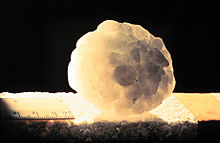
Back Hael Afrikaans Piedra (meteorolochía) AN برد (هطول) Arabic تبروري ARY Xarazu AST Sesekan ATJ Chhijchhi Aymara Dolu Azerbaijani Боҙборсаҡ Bashkir Kroša BAT-SMG

| Part of a series on |
| Weather |
|---|
|
|
Hail is a form of solid precipitation.[1] It is distinct from ice pellets (American English "sleet"), though the two are often confused.[2] It consists of balls or irregular lumps of ice, each of which is called a hailstone.[3] Ice pellets generally fall in cold weather, while hail growth is greatly inhibited during low surface temperatures.
Unlike other forms of water ice precipitation, such as graupel (which is made of rime ice), ice pellets (which are smaller and translucent), and snow (which consists of tiny, delicately crystalline flakes or needles), hailstones usually measure between 5 mm (0.2 in) and 15 cm (6 in) in diameter.[1] The METAR reporting code for hail 5 mm (0.20 in) or greater is GR, while smaller hailstones and graupel are coded GS.
Hail is possible within most thunderstorms (as it is produced by cumulonimbus),[4] as well as within 2 nmi (3.7 km) of the parent storm. Hail formation requires environments of strong, upward motion of air within the parent thunderstorm (similar to tornadoes) and lowered heights of the freezing level. In the mid-latitudes, hail forms near the interiors of continents, while, in the tropics, it tends to be confined to high elevations.
There are methods available to detect hail-producing thunderstorms using weather satellites and weather radar imagery. Hailstones generally fall at higher speeds as they grow in size, though complicating factors such as melting, friction with air, wind, and interaction with rain and other hailstones can slow their descent through Earth's atmosphere. Severe weather warnings are issued for hail when the stones reach a damaging size, as it can cause serious damage to human-made structures, and, most commonly, farmers' crops.
- ^ a b "hail". nationalgeographic.org. National Geographic Society. 21 January 2011. Archived from the original on 22 February 2021. Retrieved 14 January 2021.
- ^ "What's the difference between hail, sleet, and freezing rain?". The Straight Dope. 1999-08-06. Archived from the original on 2014-02-02. Retrieved 2016-07-23.
- ^ "hailstone". Merriam-Webster. Archived from the original on 2013-01-16. Retrieved 2013-01-23.
- ^ Cite error: The named reference
glosswas invoked but never defined (see the help page).